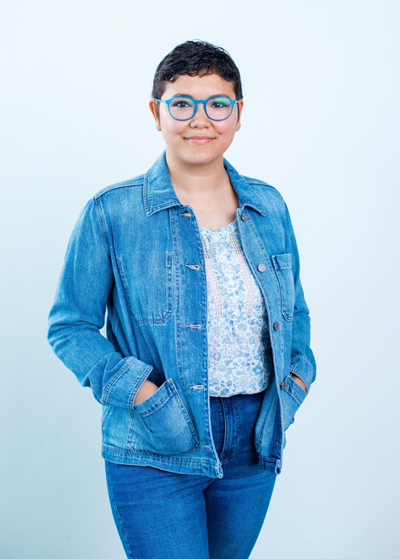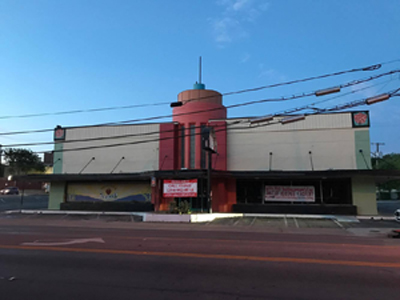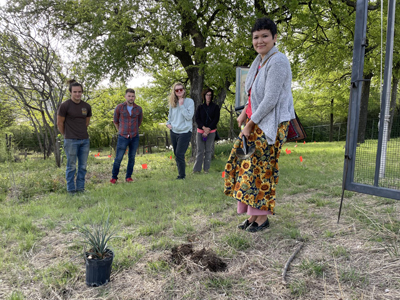Victoria Ferrell-Ortiz, Barrio Historian, Dallas, TX

Victoria Ferrell-Ortiz is a Barrio Historian of the Cemento Grande and Oak Cliff barrios of Dallas, Texas. In 2021 she served as a Co-Chair of the “Nuestro Oak Cliff” exhibit and producer of the Nuestro Oak Cliff documentary. She served as an at-large commissioner on the Arts and Culture Advisory Commission for the City of Dallas. Mrs. Ferrell-Ortiz co-founded RAYO Planning, an urban planning nonprofit. She is an alum of the Dallas Truth Racial Healing and Transformation, Racial Equity Now Cohort and was recently identified as one of six to watch on the social justice front by the Dallas Morning News.
What led you to your field?
I have operated all my life in intersectionality, whether my multi-ethnic background, my focuses on my studies, or having multiple passions in my work life. The foundation for all my work that led me to where I am today is seeing the disparities between my two families. My mother identifies as Mexican American, and my father is multi-ethnic as well but was adopted by my grandparents, who are white (why my maiden name is “Ferrell”). Growing up, I saw my father’s family live over what they needed to survive while my mother’s family often struggled daily. As a child, I noticed that one family was white and the others were people of color, but I did not have the language to articulate my concerns over what I saw. I saw a vast difference in access to amenities my white family considered essential but not fundamental for my Mexican family.
I was connected to my personal history when my family placed my paternal grandmother in a memory care facility in 2016. This memory loss helped me realize how important it was to sit with my living ancestors to collect their stories. I began recording my maternal grandmother’s history as a result.
How does what you do relate to historic preservation?
What I do is historic preservation executed in different formats. My practice is wide-ranging with my diverse experience in historic preservation, whether producing documentary films, hosting and editing Latinx podcasts, digital collage, dressmaking, or cultural art. I love using different mediums to connect to various audiences but appreciate how they can uniquely communicate messaging based on style and structure. My mission transcends the materials I use. The throughline remains uplifting our undertold stories, creating freedom and power by sharing the narrative of my community and my personal experience of the Mexican diaspora. My work centers on preserving barrio history in Dallas, Texas, (specifically the Cemento Grande and Oak Cliff barrios).

Why do you think historic preservation matters?
Our society needs to learn the histories that are under-represented because of white supremacy to broaden, deepen knowledge, and appreciate Latinx history. Another moment of galvanization for my preservation journey was the razing of a Tex-Mex restaurant in Oak Cliff called El Corazon de Tejas. Growing up, I would go to the restaurant, then-called “Tejano’s.” It was part of my bi-weekly visitation rituals with my dad. After a weekend spent with him in Carrollton, he would drop me off in Oak Cliff, and we would stop there for a delicious meal and spend quality time together. As a last-ditch effort to save the building, I hung a banner on its windows that read, “With this building goes part of our Oak Cliff heritage and history. We will NOT support a business that destroys this historic building.” Hours later, construction crews razed it to the ground to make way for a CVS Pharmacy. Since the community did not landmark the structure as one of the first Tex-Mex restaurants in the city of Dallas, it is something I can only see in my memory and photos.
What courses do you recommend for students interested in the field?
I loved what I studied in college. I would recommend any Mexican History or sociology course. I did not learn about urban planning until my senior year of college. If I ever had a chance to return, I would study urban planning. I have had the honor to co-found an urban planning nonprofit called RAYO Planning with Jennifer Rangel and Evelyn Mayo. Jennifer has helped me understand how zoning is the “gatekeeper” or “invisible fence” for everything we see in our built environment and how it’s impacted even the things I can only recollect from memory.
Do you have a favorite preservation project? What about it made it special?
There are only two standing remnants of Cemento Grande or the Trinity Portland Cement Company Town, and the Eagle Ford School is one of them. The cement company supplied the materials needed to build the school’s concrete blocks and much of the infrastructure that built up the City of Dallas. The residents of Cemento Grande installed these concrete blocks and built the schoolhouse in a Gothic Revival style in 1924. Larry Moser purchased the building and did not know what the use would be, but the Moser family felt a calling to preserve its history. It has been renovated, landmarked, and is now an event space.

Can you tell us what you are working on right now?
Beginning in 2021, I partnered with the North Texas Master Naturalists (NTMN) on their 2022 class project to add El Campo Santo de Cemento Grande or The Trinity Portland Cement Company Cemetery to their Adopt-A-Cemetery Constellation. The Trinity Portland Cement Company donated land for a cemetery near its housing villages (Cemento Grande) in 1918; the community has argued that the first burials were victims of the 1918 influenza epidemic, including many children. My grandmother’s brother is one. The project’s desired outcome was to create a monarch habitat and way station to memorialize those interred there. Campo Santo de Cemento Grande was also added to the NTMN projects list for chapter members to earn volunteer hours for additional upkeep to maintain the initial clean-up and plantings.
How do you think the national historic preservation programs help your community?
Online courses are very impactful for equity purposes. I can see that ACHP does outreach to young people, which is so vital for creating a strong sense of historical knowledge and connection earlier in people’s lives.
Do you have advice for novice preservationists?
This is also a message I need to hear myself. Make time to research. It is very time-consuming but digging into the resources, texts, and people you have access to is a huge undertaking but so crucial. Break it down into bite-sized pieces, so it feels manageable to your schedule. Organize as you go and have grace with yourself.
The ACHP’s mission is “preserving America’s heritage;” can you give us an example of how your community is preserving its heritage?
Día de los Muertos is a celebration of people who have passed away, primarily celebrated in Latin America and has Indigenous roots. It is a day where we honor the memories and lives of our loved ones who have passed on. There are many traditions for this celebration. One is creating ofrendas or altars where acquaintances or family members place loved ones’ pictures and some personal memorabilia, foods, drinks, and flowers. This practice helps us recount the stories of our friends and families, so their memories can live on through us.
How has your career as a barrio historian/cultural artist helped you realize that there needs to be more historic preservation for the Latino/Hispanic community?
People who have degrees of separation from our narratives tell our stories. When done through a lens of allyship, this can be acceptable, but many times that is not the optimal approach. Our history must be told by us and for us. I see tremendous opportunity for earlier connection to history for the next generation of joven (young) historians.
How does barrio history and cultural art relate to historic preservation?
Understanding an honest history can help us hold power in our communities to create a more inclusive, equitable, and just future. I did not learn local history in my academic career but was blessed to have been able to connect to it after college. Knowing your barrio’s history and culture sets the foundation for preservation work.
Read more Q&A stories about the Preservationists in Your Neighborhood!